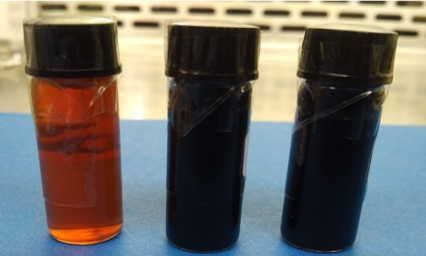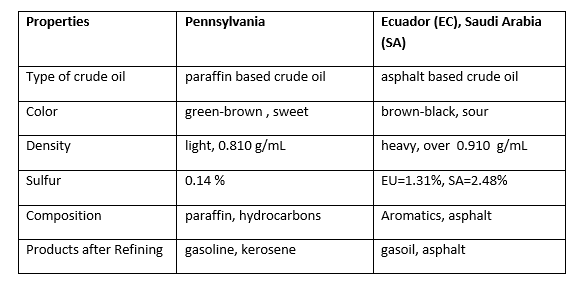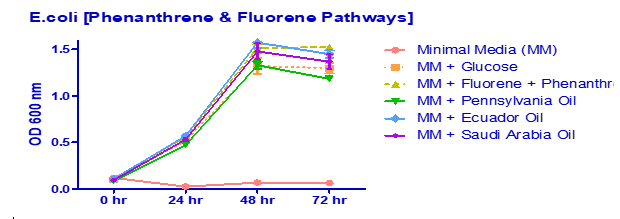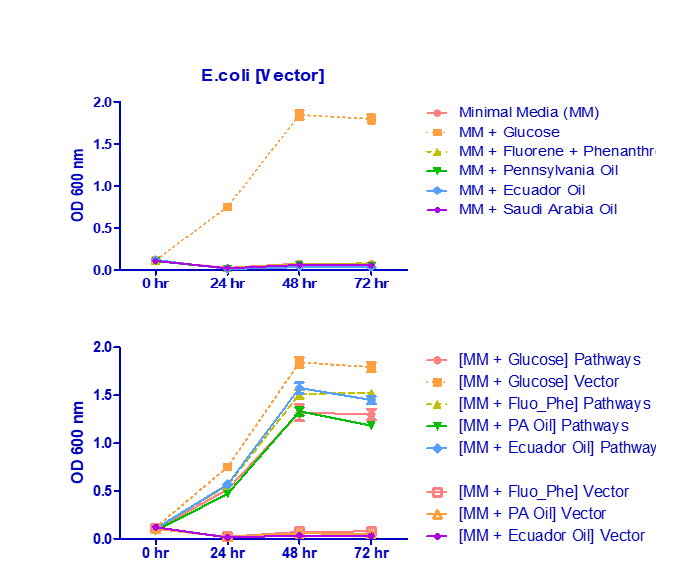Part:BBa_K2491025
Combination of Part 1 and Part 2 of Fluorene Degradation - 101
Ligation of F2_XbaI_PstI into 101_F1_EcorI,SpeI
Ligation of F2_XbaI_PstI into 100_F1_EcorI,SpeI
Creation of proteins used for the catalyst of the Fluorene degradation pathway.
This shows the proof that this sequence works as intended: Creation of proteins used for the catalyst of the Fluorene degradation pathway. (For the Silver Requirement) Clones were named differently throughout the experiment.
Clone 48: K2491013
Clone 51: K2491025 (What the Page is About)
Clone 54: K2491026
EXPERIMENTAL DESIGN In order to assess whether the newly engineered E.coli strains containing the fluorene catabolic pathway was able to degrade their respective PAH, they were grown in minimal medium supplemented with fluorene as a sole source of carbon. For controls, the strains were grown in presence of glucose. In addition, E.coli strains containing the corresponding vector without insert was also grown in parallel. Fluorene was prepared as stock solution of 10 mg/mL and was initially dissolved in methanol. Because the stock solution showed a slight precipitate, stock solutions of 10 mg/mL was also prepared in the organic solvent dimethyl sulfoxide (DMSO). Growth comparisons using these 2 solvents were performed in parallel.
CULTURE SETUP Cultures were started from glycerol stock in 4 mL of medium and incubated at 37°C. The OD readout of the overnight cultures was determined using a spectrophotometer according to the protocol shown above. All cultures were then diluted to 0.02 using the volume below and OD measurements were determined at the indicated time points.
The data show all absorbance measurements obtained during the biotransformation of fluorene by our recombinant E.coli in minimal medium supplemented with PAHs. To evaluate whether the recombinant cells had the ability to transform PAHs, growth experiments were set up with various clones expressing the fluorene catabolic pathway. The clones described above with the catabolic pathway under the control of 3 different constitutive promoters were set in cultures using minimal medium supplemented with fluorene (0.1 mg/mL) as sole source of carbon (figures below). Antibiotics were added as appropriately. Clones containing the catabolic pathway exhibited higher cell density at 48 hours compared to their respective controls (vector alone) with the strongest promoter given a greater advantage (clone 48 or K2491013 for fluorene). PAHs dissolved in DMSO appeared slightly more available than PAHs dissolved in methanol. This may be explained by the fact that PAHs stock solutions prepared in methanol exhibited some precipitates not observed with DMSO-based stocks.
Figure 1. Growth of recombinant E.coli BL21DE3 cultures harboring the control plasmid pSB3T5 or the fluorene pathway under the control of 3 different constitutive promoters: BBa_J23100 (clone 48), BBa_J23101 (clone 51), and BBa_J23110 (clone 54) cloned into pSB3T5. Data points represent value averages of duplicate of OD at 600 nm taken over time for 2 independent colonies per clone. Recombinant clones were grown in minimal medium supplement with tetracycline (15 µg/mL) and fluorene (0.1 mg/mL). Fluorene was dissolved in 100% DMSO (Top panel) or 100% methanol (Bottom panel).
Growth comparison of recombinant E.coli in minimal medium supplemented with PAHs and glucose. In order to evaluate the role of toxicity and/or the metabolic burden caused by the PAH catabolic genes and the PAHs, namely fluorene, cells were grown in minimal medium together with fluorene and glucose as carbohydrate sources (figures below). It appears that all 3 clones carried by a low copy plasmid number with the fluorene catabolic pathway under the control of 3 promoters of various strengths behaved similarly to the control strain harboring the corresponding vector pSB3T5 with no insert. The fluorene genes independently of their expression level do not appear to impact cell growth when carried by a low copy vector. In addition, fluorene (0.1 mg/mL) in presence of glucose is not toxic to the cells.
Figure 3. Fluorene biotransformation experiment using recombinant E.coli BL21DE3 harboring the control plasmid pSB3T5 or the fluorene pathway under the control of 3 different constitutive promoters: BBa_J23100 (clone 48), BBa_J23101 (clone 51), and BBa_J23110 (clone 54) cloned into pSB3T5. Data points represent value averages of duplicate of OD at 600 nm taken over time for 2 independent colonies per clone. Recombinant clones were grown in minimal medium supplement with tetracycline (15 µg/mL), fluorene (0.1 mg/mL), and glucose (0.4%).
EXPERIMENTAL DESIGN
This study was aimed at determining the growth rate of the recombinant strains containing the fluorene catabolic pathway alone or together when using fluorene as sole source of carbon. Recombinant cells were grown in minimal medium supplemented with fluorene as a sole source of carbon. For controls, the strains were grown in presence of glucose. In addition, E.coli strains containing the corresponding vector without insert was also grown in parallel. PAHs were dissolved in DMSO.
CULTURE SETUP
Cultures were started from glycerol stock in 4 mL of medium and placed at 37°C. The OD readout of the overnight cultures was determined using a spectrophotometer according to the protocol shown above. All cultures were then diluted to 0.02 using the volume below and OD measurements were determined at the indicated time points.
Graph 3. Average absorbance values measured in quadruplet at 600 nm of cultures of 2 independent colonies of control (vector) and catabolic plasmid (clone CCA-48 or K2491013 for fluorene) at 2, 4, 24, and 48 hours after inoculation of minimal media supplemented with fluorene at 0.1 mg/mL with or without glucose (0.4%) at 25. All media contained the surfactant Tween-20 (0.1%). Cultures were grown at 25°C or 37°C. MM= Minimal Medium, Glu= Glucose; Ave.= Average; OD=Optical Density; SD= standard deviation.
EXPERIMENTAL DESIGN
This study was aimed at determining the growth rate of recombinant E.coli BL21(DE3) strains containing the phenanthrene catabolic pathway and the fluorene catabolic pathway together when using minimal medium and crude oil as a source of carbon (0.01%). Controls consisted of E.coli strain containing the corresponding vectors with no insert and culture growth on minimum medium with or without glucose (0.4%).
Figure 5. Crude oil samples from Pennsylvannia, Ecuador, and Saudi Arabia (left to right).
CULTURE SETUP
E.coli BL21(DE3) recombinant cells containing both plasmids CCA-57 and CCA-48 were first grown at 37°C from glycerol stock in 4 mL of LB medium with both chloramphenicol and. CCA-57 harbored the phenanthrene pathway on vector pSB1C3 and clone CCA-48 harbored the fluorene pathway on vector pSB3T5. Recombinant cell cultures of the corresponding vectors with no catabolic inserts were initiated in a similar fashion. Overnight cultures were spun and resuspended in 4 mL of minimal medium. OD of all cultures was measured at 600 nm using a spectrophotometer. All cultures were then diluted to 0.02 using the volume determined in the table below. Growth experiments were initiated in minimal medium with no carbohydrate source, with glucose (0.4%), with phenanthrene and fluorene (0.1 mg/mL each) from a stock solution of 100 mg/mL prepared in DMSO, or with crude oil (0.01%). No antibiotics were added to the minimum medium. Three sources of crude oils were tested: Pennsylvania, Ecuador, and Saudi Arabia.
. RESULTS AND DISCUSSION: Time course study of culture growth of recombinant E.coli BL21(DE3) in minimal medium in presence of crude oils
In order to evaluate whether the recombinant cells had the ability to transform PAHs in crude oil samples, growth experiments were set up with a recombinant clone expressing both the fluorene and the phenanthrene catabolic pathways. The clone with the catabolic pathway under the control of the strongest constitutive promoter [CCA-48 for fluorene and CCA-57 for phenanthrene] was set in cultures using M9 minimal medium supplemented with fluorene (0.1 mg/mL) and phenanthrene (0.1 mg/mL) as sole source of carbon in presence of Tween (0.1%), or with crude oils from three sources. As illustrated in the table above reporting the average of 8 data points (Optical Density) of cultures, the recombinant E.coli containing the biodegradation pathway could utilize crude oils whereas the control bacteria containing the vector only could not. Minimal media was used as medium for culture. Strains could all grow in presence of glucose when used as a carbon source.
Figure 6. Time course biotransformation experiments using crude oil samples from Pennsylvania (PA), Saudi Arabia, and Ecuador, measuring absorbance at 600nm of E.coli BL21 recombinant cultures containing the fluorene and phenanthrene catabolic pathways or control vectors. MM=M9 minimal medium.
Sequence and Features
- 10COMPATIBLE WITH RFC[10]
- 12INCOMPATIBLE WITH RFC[12]Illegal NheI site found at 7
Illegal NheI site found at 30
Illegal NheI site found at 3149
Illegal NheI site found at 3172 - 21INCOMPATIBLE WITH RFC[21]Illegal BglII site found at 5231
- 23COMPATIBLE WITH RFC[23]
- 25INCOMPATIBLE WITH RFC[25]Illegal AgeI site found at 5049
Illegal AgeI site found at 6061 - 1000INCOMPATIBLE WITH RFC[1000]Illegal BsaI site found at 403
Illegal BsaI.rc site found at 1515
Illegal SapI.rc site found at 5592
| None |








